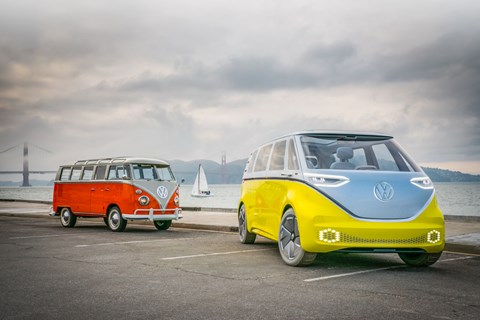► ID Buzz vs Microbus
► EV vs classic camper
► Old VW vs new
If in 1967 you were cruising around San Francisco’s Haight-Ashbury district in your VW camper van you could easily have bumped into Janis Joplin, or perhaps Jefferson Airplane singer Grace Slick, or maybe Jerry Garcia of the Grateful Dead. Close to the Golden Gate Bridge, the area was home to these icons of the emerging hippy counterculture, who’d moved there because it was cheap. They were very soon followed by groupies, dealers, daytrippers and others lured by the idea of sex, drugs and rock ’n’ roll. It quickly soured, and the icons either died or moved on. But the VW bus stayed.
Legendary hippy-era rock ’n’ roll venues like Fillmore West and the Avalon Ballroom are no more, but 50 years on certain parts of the city still move to the music of the Dead, Quicksilver Messenger Service and the Doors. To this day, the area is still seen as the mecca for latterday hippies; at once promised land and tourist trap. At times San Francisco seems slightly embarrassed by all this, but at others it’s keen to encourage it.
And so it is with VW and the Microbus, or Kombi, or Transporter, or Type 2 (when the Beetle was Type 1). Call it what you will, it was launched in 1950 with a rear-mounted air-cooled engine that kept the whole vehicle simple and relatively roomy. It evolved a bit, but the basic idea was so strong that variations on the theme were still being built decades later. Initially intended as a load carrier and/or passenger van, it was available in large quantities as a pre-loved bargain by the time the hippies emerged. Chiming with their communal ethos, it could combine elements of crash pad, beach hut and Greyhound bus.
Meanwhile, 6000 miles to the east of Haight-Ashbury, and about 2000 light years away from the Summer of Love, my first school bus was a 30bhp 1957 VW T1 painted in subdued post-war blue-grey and trimmed with a best-forgotten mix of rubber and leatherette. I usually sat up front, my right foot resting on the grey tin blister that protected the headlamp assembly from the inside. There was no radio, no heater worth mentioning and no seat adjustment, just sliding side windows to fiddle with, which I did incessantly. We made our own entertainment in those days.
So when we go for a drive around San Francisco in a prototype of 2022’s VW ID Buzz electric MPV along with a 1952 Mk1 Microbus, it’s both a reminder of the past and a taste of the near future. A prototype it may be, but this feels production ready, and it provides a vivid demonstration of how electric propulsion, autonomous driving and digitisation are going to redefine the mission of the motor car over the next 10 to 15 years.
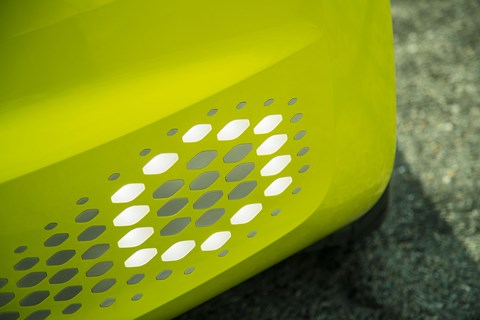
VW has shown many possible 21st century Microbuses, but this is the one that’s really going to make it into production, in a finished form that’s close to this concept. The combination of ID electric thinking and funky camper-van packaging has proved irresistible: get rid of the internal combustion engine and you free up some valuable space, and simultaneously you acquire the green credentials your target market demands. The initial buyers won’t be alternative-lifestylers any more than they were for the original in 1950, but they will certainly want their new acquisition to alert the world to the fact that they’re more in tune with shiny Silicon Valley than stinky Detroit.
If the reception the prototype got on our tour of San Francisco is anything to go by, VW’s on to a winner. We head to the hippy heartland to canvass opinion, and bang on cue two time-warped hippies called Dean and Don stumble into our convoy. The T1 triggers all sorts of positive vibes for them, while many more forward-looking San Franciscans regard the ID Buzz as a serious alternative to the electric car or hybrid they currently run. When it arrives in 2022, VW intends to sell the ID Buzz at a price close to a base-level long-wheelbase Transporter T6 (which becomes the T7 in 2019), currently around £30,000. That’ll be way too much for Dean and Don, but a tempting proposition for Tesla or Prius-driving middle-class families.
And once their attention has been grabbed by the Buzz, there will be a choice of IDs waiting for them. VW is envisaging a whole new family of electric vehicles, rather than a bunch of pre-existing models with their engines replaced by electric powertrains.
We’re driving the ID Buzz just three days after VW publicly confirmed that the project will be going into production. It will, in fact, be the last of the first batch of VW ID models to come to market. Wolfsburg’s e-attack begins in early 2020 with the Golf-size ID (the cover car from our March issue) and the Tiguan-size ID Cross. In 2021, we expect to see the boxy Touareg-size ID SUV and the seven-seat ID Lounge, a crossover coupé with MPV cabin space. As well as the ID Buzz, the plan for 2022 includes a large version of4 the ID Aero saloon, followed in 2023 by a five-seat Aero derivative.
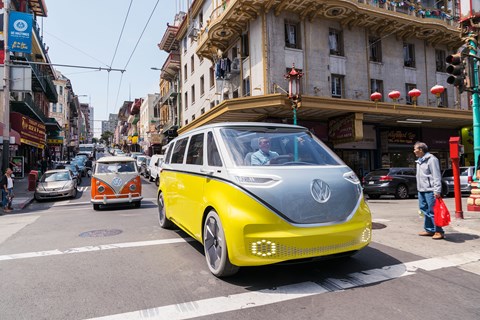
What, I asked chief designer Klaus Bischoff, is the essence of the ID design language? ‘It’s all about architecture. Now that we must no longer accommodate the combustion engine, we are free to create new proportions typical of zero-emission vehicles. In the beginning, the battery packs mounted between the axles may result in slightly taller rooflines. But at the same time, the wheelbase will grow, the overhangs can shrink up to a point, and the greenhouse may stretch further forward. The rule is that there is no rule.
‘How do I make sure people still know it’s a Volkswagen? The logo features big front and rear, and as we know it from VW originals like Beetle, Karmann Ghia and the first Microbus, the trademark body-colour front end no longer needs a conventional grille. Instead, there will be a full-width air intake at the bottom of the bumper.’
How does the ID look differ from the rest of the VW range?
‘A Golf must always be recognisable as a Golf. With ID, we started with a clean sheet of paper – revolution instead of evolution! When we do an MEB saloon, it is therefore not a battery-powered Passat but a stylish low-drag statement badged ID Aero. It’s possible to create a back-to-the-roots car and make it part of the ID family, but it is also possible to come up with something that is space-age daring. There is so much you can do when limitations like engine and exhaust no longer apply. Having said that, we are planning to conceive certain signature details – lights, wheels, trim, cutlines – which will be unique to our zero-emission models.’
Which elements of the futuristic interior in the ID Buzz will make it into production?
‘The beauty of MEB is its packaging advantage,’ says Bischoff. ‘Even when you don’t change the footprint over the petrol-engined sister model, the cabin space goes up automatically by one full size. The Golf-class ID is for instance every bit as roomy as the Passat. A bespoke electric Up would share the approximate interior dimensions with the Polo. Better still, the increased floor space is totally uncluttered and flat. This encourages enhanced flexibility between passenger and cargo space, a variety of seating arrangements and different vehicle characteristics ranging from a high-end lounge on wheels to a delivery van.
‘For now, the steering-wheel and the pedals will stay in place, but we are in the process of reinventing the ergonomics via voice control, an augmented reality head-up display and a more intuitive touchpad.’
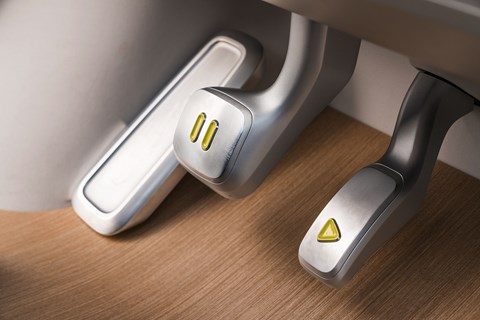
The Buzz’s proportions and silhouette instantly evoke the original, aided by details such as the two-tone paint and the three horizontal air intake streaks in the D-posts. The resemblance4 is more than skin deep, too. Both VWs drive the rear wheels (all-wheel drive will be optional in the Buzz), both are spacious and easy to get in or out of. From behind the wheel of the T1, the electric great-grandchild looks huge; the measuring tape says its wheelbase is 600mm longer and the overall width 150mm greater.
Most hand-built one-off design exercises struggle to move, but the ID Buzz is swift and agile around San Francisco, marred only by a grabby action to the energy-recovering brakes. The turning circle is usefully tight for traffic busting and the single-speed transmission operated via buttons on the steering wheel hooks up with instant-torque vigour to fire you into gaps.
‘We built this model to be fully operational,’ says Dzemal Sjenar, a senior concept car engineer. ‘So go for it, don’t worry too much about wear and tear, and rest assured that a single charge will safely take you through a 12-hour day.’ Which is exactly what we do, a digital hippy leading its analogue ancestor.
The original rear-engined Microbus powered by that rough air-cooled boxer engine was kind of a Porsche 356A with seven seats. Between the ages of 18 and 22 I financed my modest university career by delivering drugs to pharmacies in the greater Munich area at the wheel of T2s and T3s. They were gutless and short of breath, and required a great deal of patience. The T1 we’re driving today has a huge, nearly horizontal two-spoke steering wheel that lacks any trace of precision, the clutch is heavy and long-travel and the four drum brakes are as likely to lock up and pull to one side as they are to actually stop you. It takes us about 90 seconds for the 50lb ft of torque and 25bhp to get us to the 53mph top speed.
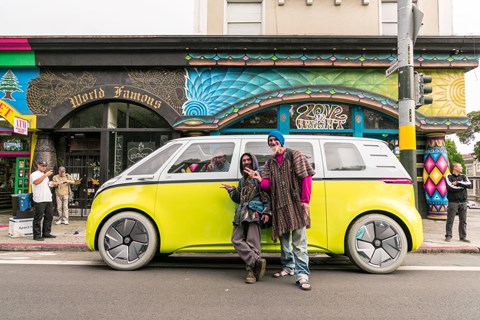
The ID Buzz is a different animal altogether. In top-of-the-line guise, the 150kW (198bhp) rear motor is complemented by a 125kW (165bhp) motor driving the front wheels. This aggregate 275kW (363bhp) is claimed to be able to get the two-tonner from zero to 62mph in about five seconds. The lesser version combines all-wheel drive with a pair of powerplants delivering 225kW (297bhp). The entry-level Buzz relays 150kW (198bhp) exclusively to the rear wheels. The three different power packs are paired with three different battery sizes good for 60, 83 and 111kWh. Irrespective of output, the top speed is limited to 100mph. According to the new WLTP tests, the range varies between about 250 and 300 miles.
Like every future electric Volkswagen, our two-tone crowd-stopper sits on the modular electric architecture (MEB), being developed from scratch. The heart of this fully scalable matrix is the rigid battery cradle, which is inside a honeycomb frame for optimum side impact protection. Accessible from below for repair and replacement, it accommodates between three and five energy packs positioned to ensure a near-50:50 weight distribution (actually 48:52, fact fans). The lightest, least powerful ID Buzz is claimed to weigh 400kg less than the conventional T6, so emission-free motoring and obesity are not inevitably connected. The MEB layout warrants a low centre of gravity as well as exceptional space utilisation. While the front axle relies on MacPherson struts, the rear suspension is multi-link. The concept car uses conventional springs and dampers, but by 2022 you’ll also be able to specify adjustable air suspension and even rear-wheel steering.
It’s much too quick for its arthritic sibling – in fact it beats any 911 over the first 25 yards of travel – and it cracks open the door to a new level of near-silent lounge-like roominess. The interior is light and airy, the space strikingly minimalist. Strangely enough, the ancient spring-loaded seats of the T1 cope better with Southern California’s third-world roads than the contemporary foam buckets. And the old-fashioned lever-operated parking brake provides a more positive feedback than that whirring push-button stopper. But then the ride comfort is infinitely superior on the Buzz.
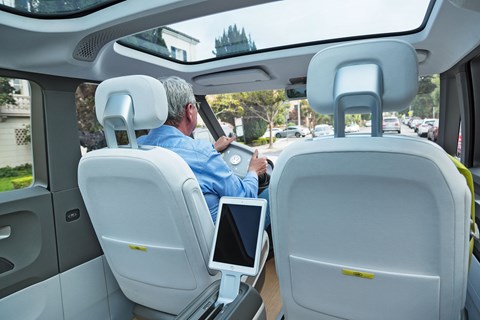
Although the show car is physically quite close to the real thing, the definitive dimensions have still to be finalised. We expect a vehicle 4650mm long, 1910mmwide and 1870mm high, and with a wheelbase of 2950mm. Comments Sjenar: ‘The idea is to be marginally smaller on the outside than the standard-wheelbase T6 while at the same time offering as much interior space as the lwb version.’ Featuring adjustable swivelling seats up front and a sofa-like bench as row three, the ID Buzz accommodates up to eight in style and comfort. Like in a Boeing Dreamliner, the rear side windows can be dimmed for that coveted cocooning effect.
Although the concept car comes with a retractable steering wheel and a battalion of sensors and cameras, demonstrating that autonomous driving is very much on its agenda, it’s unclear when those technologies will be available on the ID Buzz.
I asked VW CEO Herbert Diess about the prospect of electric versions of other VW icons such as the Beetle and Scirocco. ‘We are indeed working on a number of projects that match this description,’ he said. ‘But rather than replacing existing bodystyles with more of the same, why not try the heritage-meets-future approach with a dual-cab pick-up or a modern reinterpretation of the Karmann Ghia?’
An intriguing prospect. And if the other retro-futurist mash-ups can be as good as the ID Buzz, then this really is the dawning of an exciting new age.
Check out our comparison tests
